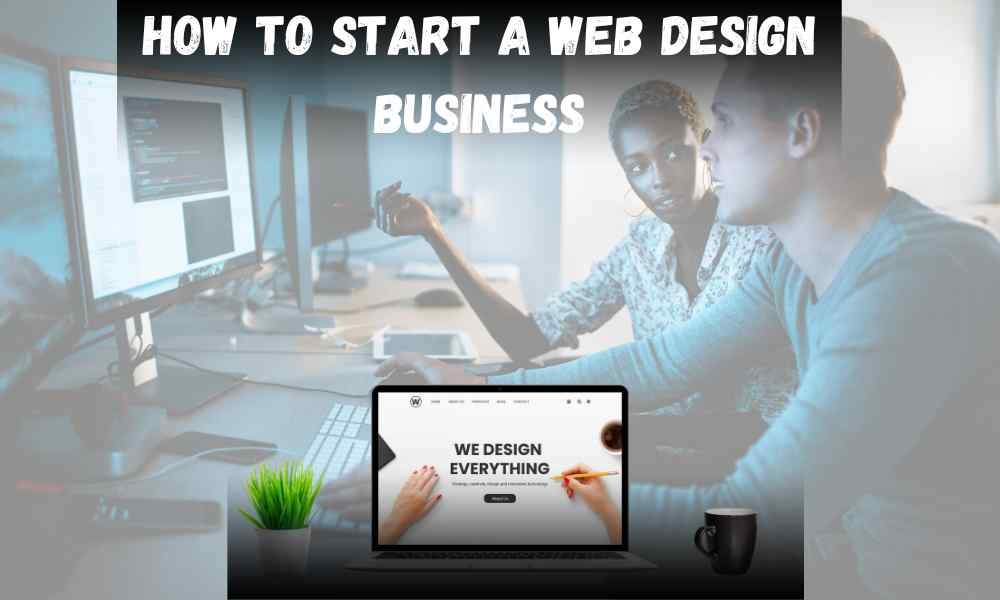Getting started with your web design business.
Embarking on the journey to start your own web design business can be an exhilarating endeavor filled with opportunities for creativity, growth, and financial success. As a web designer, you have the chance to transform your passion for design and technology into a thriving business that caters to clients’ needs and contributes to their online success. Whether seasoned or new, this guide offers valuable insights and practical advice to launch and expand your web design business.
How much can you earn? Let’s find out!
One of the most common questions aspiring web designers have is about the earning potential of starting a web design business. While the exact earnings can vary based on factors such as your level of experience, the quality of your work, and the demand for web design services in your area, starting a web design business can be financially rewarding. Many successful web designers earn a comfortable income by offering their services to clients ranging from small businesses and startups to large corporations and organizations. Through excellence in work, a robust portfolio, and strategic marketing, you can draw clients and secure competitive rates for your web design skills.
How to Start a Web Design Business with No Experience
To start a web design business without experience might seem hard, but it’s doable. Here’s a simple guide to help you start:
- First, learn the basics of web design online. Practice by working on personal projects or making websites for friends and family.
- Then, create a portfolio to showcase your work, even if it’s just personal projects. This will help you impress potential clients.
- Network with other web designers and attend events to learn more and meet people. You can also use websites like LinkedIn to find work.
- Start small and take on easier projects at first. As you get better, you can tackle more challenging jobs.
- Keep learning and improving to stay ahead in the web design world. With effort, you can turn your passion into a successful business.
What You Need to Start
Skills and Experience for Web Design Business
Before diving into the world of entrepreneurship, it’s essential to have a solid foundation of web design skills and experience. Familiarize yourself with HTML, CSS, JavaScript, and other programming languages commonly used in web development. Additionally, hone your design skills by studying principles of layout, typography, color theory, and user experience design. Internships, freelance gigs, or agency work offer hands-on experience, aiding portfolio development and impressing potential clients with your skills.
Tools and Equipment for Web Design Business
Equipping yourself with the right tools and equipment is essential for delivering high-quality web design services. Invest in industry-standard software such as Adobe Creative Suite, Sketch, or Figma, which offer powerful tools for designing websites and user interfaces. Additionally, ensure you have access to a reliable computer with sufficient processing power and memory to handle graphic design software and web development tools. High-resolution monitors, graphics tablets, and ergonomic office furniture can also enhance your productivity and comfort while working on design projects. When choosing tools, prioritize personal requirements, opting for quality items that enhance creativity and uphold professionalism, aligning with your goals.
Portfolio for Web Design Business
Show off your work to attract clients. Your portfolio is your most powerful marketing tool as a web designer. It showcases your skills, expertise, and design style to potential clients and provides them with tangible evidence of your ability to deliver high-quality work. Showcase a variety of projects in your portfolio to exhibit versatility and creativity, including websites, apps, e-commerce platforms, and branding materials. Highlight your role in each project, the challenges you faced, and the solutions you implemented to overcome them. Include testimonials or reviews from satisfied clients to add credibility and social proof to your portfolio. Regularly update your portfolio with new projects and remove outdated or irrelevant work to ensure it accurately reflects your current skills and expertise.
Budgeting for Success
Lessons Budget:
Investing in your education is crucial for staying competitive in the fast-paced world of web design. Allocate funds for online courses, workshops, and seminars to expand your skills and stay up to date with industry trends. Many reputable online platforms offer courses in web design, graphic design, user experience design, and other related topics. Enroll in courses led by seasoned professionals or instructors with industry credentials for top-notch instruction and insights on current web design practices.
Equipment Budget:
Plan for the expenses of software and tools. Building a solid foundation of tools and equipment is essential for running a successful web design business. Allocate a budget for purchasing software licenses, upgrading your hardware, and investing in other essential resources. While some software tools offer free versions or trial periods, consider investing in premium versions or subscription plans that provide access to advanced features, technical support, and regular updates. Additionally, factor in ongoing expenses such as software subscriptions, web hosting fees, and domain registration costs when budgeting for your web design business.
Marketing Budget:
Don’t forget about promoting your business. No matter how talented you are as a web designer, if nobody knows about your business, you won’t get any clients. Allocate a portion of your budget for marketing and advertising efforts, including website development, social media marketing, and networking events. Consider hiring a professional photographer or videographer to create high-quality visual content for your website and social media profiles. Invest in paid advertising on platforms like Google Ads or Facebook Ads to reach potential clients and drive traffic to your website. Engage with industry peers, attend events, and participate in online communities to boost visibility and attract clients through referrals.
Steps to Launch Your Business
Step 1: Learn the Ropes
Before diving headfirst into entrepreneurship, take the time to hone your skills and gain experience in the field of web design. Enroll in online courses, participate in workshops, and seek mentorship from experienced professionals. Practice your design skills by working on personal projects or volunteering to create websites for friends, family members, or local businesses. Embrace opportunities to learn from your mistakes and refine your techniques as you progress on your journey to becoming a successful web designer.
Step 2: Build Your Portfolio
A strong portfolio is essential for attracting clients and showcasing your expertise as a web designer. Create a professional portfolio website showcasing your best work, testimonials from satisfied clients, and your unique design style. Use high-quality images and compelling copy to highlight the features and benefits of each project and organize your portfolio in a way that makes it easy for potential clients to navigate and explore. Incorporate case studies showcasing your design process, problem-solving abilities, and creativity, offering valuable insights to potential clients. Keep your portfolio updated and relevant.
Step 3: Find Your Niche
Identifying your niche within the web design industry can help you stand out from the competition and attract clients who value your expertise. Consider specializing in a specific industry or type of website, such as e-commerce sites, portfolio websites, or informational blogs. Alternatively, focus on a particular design style or approach, such as minimalist design, retro-inspired aesthetics, or playful illustrations. Specialize in a specific area to establish expertise, distinguishing yourself from generalists who provide generic web design solutions.
Step 4: Get Legal
Before launching your web design business, ensure that you have all the necessary legal documents and permits in place. Consult with a lawyer to draft contracts, terms of service, and other legal documents to protect yourself and your clients. Consider forming a legal business entity, such as a sole proprietorship, partnership, or limited liability company (LLC), to protect your personal assets and minimize your liability exposure. Obtain any required business licenses or permits from your local government or regulatory agencies and familiarize yourself with relevant laws and regulations governing web design businesses in your area.
Step 5: Set Your Prices
Determining your pricing strategy is essential for running a profitable web design business. Consider factors such as your level of experience, the complexity of the project, and market rates when setting your prices. Maintain transparency by clearly outlining pricing structures and detailing additional costs like hosting, domain registration, and ongoing maintenance fees to clients. Consider offering tiered pricing packages or customized quotes based on the specific needs and goals of each client. Communicate the value of your services and the benefits of investing in professional web design to justify your pricing and build trust with your clients.
Step 6: Spread the Word
Marketing is key to the success of any business, including a web design business. Utilize a combination of online and offline marketing tactics to promote your services, including social media marketing, email marketing, networking events, and word-of-mouth referrals. Create a professional website that showcases your portfolio, highlights your services, and provides valuable content and resources for potential clients. Optimize your website for search engines by using relevant keywords, creating high-quality content, and building backlinks from reputable websites in your industry. Utilize Facebook, Instagram, and LinkedIn to engage potential clients, showcase your portfolio, and interact actively with your audience. Consider partnering with complementary businesses or professionals in related fields to expand your reach and access new client opportunities.
Step 7: Launch Your Business
Once you’ve completed all the necessary preparations, it’s time to officially to start your web design business. Celebrate this milestone and start reaching out to potential clients, showcasing your portfolio, and building relationships within your industry. Consider hosting a launch event or promotion to generate excitement and attract attention to your new business. Be prepared to handle inquiries and requests for quotes from potential clients and be proactive in following up with leads and converting them into paying clients. Stay focused, stay motivated, and stay committed to providing exceptional service and value to your clients as you embark on this exciting new chapter in your web design journey.
User Query: Comparing Earning Potential
Many aspiring web designers wonder how the earning potential of a web design business compares to other online businesses. While the exact earnings can vary depending on factors such as your level of experience, the quality of your work, and market demand, web design can be a lucrative career path for those with the right skills and dedication. Unlike some online businesses that rely on passive income streams or require significant upfront investment, web design offers the opportunity to earn a steady income by providing valuable services to clients. With the increasing demand for websites and digital marketing services, the potential for growth and profitability in the web design industry remains strong. By delivering high-quality work, building a strong reputation, and cultivating long-term relationships with clients, you can build a successful web design business that provides a stable income and a rewarding career path for years to come.
Conclusion
to start a web design business requires a combination of skills, experience, and entrepreneurial spirit. By following the steps outlined in this guide and investing in your education, tools, and marketing efforts, you can build a successful web design business that fulfills your creative ambitions and provides a steady income stream. So, are you ready to turn your passion for design into a thriving business? Let’s get started!




